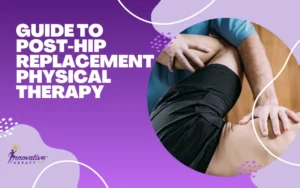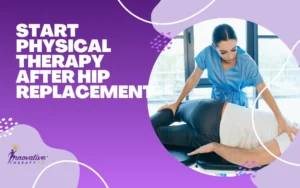If you’re struggling with shoulder pain, you’re not alone. It’s a common issue that can significantly impact your daily life, but there’s hope. Welcome to our comprehensive guide on shoulder pain physical therapy. This post will explore practical strategies and techniques to alleviate discomfort and enhance mobility. We aim to provide valuable insights and practical solutions to address your shoulder pain. So, whether you’re dealing with a recent injury or chronic pain, stay tuned as we delve into the world of physical therapy and unlock the path to a pain-free life.
Best Physical Therapy Methods for Treating Shoulder Pain and Injuries

In dealing with shoulder pain and injuries, physical therapy emerges as a highly effective and comprehensive approach. Let’s thoroughly explore some of the top methods of physical therapists to address shoulder issues.
Range of Motion Exercises
One of the fundamental aspects of physical therapy for shoulder pain is to restore and improve the range of motion. Range of motion exercises involve gentle movements aimed at gradually increasing the flexibility and mobility of the shoulder joint. These exercises help loosen tight muscles and ligaments while preventing stiffness, often associated with shoulder injuries.
Manual Therapy Techniques
Physical therapists often use manual techniques like joint mobilizations and soft tissue massage to ease pain and enhance shoulder function. Joint mobilizations gently manipulate the shoulder joint to bring back its normal movement. Soft tissue massage reduces muscle tension, releases trigger points, and improves blood flow for healing and pain relief.
Modalities
Physical therapists may also utilize various modalities to complement other treatment approaches. These modalities include heat therapy, cold therapy, ultrasound, electrical stimulation, and laser therapy. Heat therapy relaxes muscles and boosts blood flow, while cold therapy decreases inflammation and numbs the area. Ultrasound and electrical stimulation can speed up tissue healing and ease pain for chronic shoulder issues.
Functional Training
Functional training blends strength, flexibility, and stability exercises with daily activities or tasks related to work, sports, or hobbies. It mimics real-life movements to boost shoulder confidence and lower the chance of future injuries.
Common Injuries that Lead to Shoulder Pain Treatment
Understanding the underlying causes of shoulder pain is essential for effective treatment. Let’s explore two main categories of shoulder injuries: sudden injuries and overuse injuries.
Sudden Injuries
Shoulder injuries that happen suddenly usually happen because of accidents like falls, sports mishaps, or car crashes. These quick injuries can involve broken bones, joints popping out of place, or damage to ligaments and muscles around the shoulder. When these injuries occur, you’ll feel immediate pain, see swelling and bruises, and might find it hard to move your shoulder. Getting checked by a physical therapist immediately is essential to stop more harm and help you get better.
Overuse Injuries
Shoulder overuse injuries happen slowly from doing the same movements, like repetitive actions, bad body mechanics, or putting too much stress on the shoulder.Athletes, workers with physical jobs, and people who do overhead tasks, like swimming or lifting, often get these injuries.
Common ones include rotator cuff tendinitis, bursitis, impingement syndrome, and labral tears. Overuse injuries are constant shoulder pain, stiffness, weakness, and trouble moving the arm. Physical therapy is crucial for handling these injuries. It figures out what’s causing them, changes how you do activities, and uses special exercises to get your shoulder working well again.
How Physical Therapy Can Help With Shoulder Pain and Shoulder Injuries
Physical therapy is a dynamic and comprehensive approach to addressing shoulder pain and injuries. It goes beyond mere symptom relief, aiming to identify the root causes of the pain and dysfunction. Let’s delve into how physical therapy proves instrumental in alleviating shoulder issues.
Individualized Assessment and Treatment Plans
Effective physical therapy starts with carefully assessing each person’s unique situation. Physical therapists look into details like medical history, lifestyle, and specific shoulder problems. This personalized approach helps them create custom treatment plans targeting the reasons behind shoulder pain and injuries.
Pain Management Strategies
Shoulder pain can be debilitating, impacting daily activities and overall quality of life. Physical therapists employ various pain management strategies to provide relief and promote healing. These may include heat or cold therapy, electrical stimulation, and manual therapy techniques to reduce muscle tension and inflammation.
Range of Motion and Flexibility Exercises
Restoring and enhancing the range of motion is a crucial focus of physical therapy for the shoulder. Therapists prescribe specific exercises that target flexibility and mobility, gradually improving the shoulder’s ability to move without pain or discomfort. Range of motion exercises may include pendulum, passive stretches, and joint mobilizations.
Strengthening Protocols
Building strength in the muscles surrounding the shoulder is essential for stability and support. Physical therapists design customized strengthening protocols, emphasizing exercises that target the rotator cuff muscles, deltoids, and scapular stabilizers. Progressive resistance training is often implemented to increase strength and endurance gradually.
Neuromuscular Re-education
Improper movement patterns or muscle imbalances can contribute to shoulder pain and injuries. Neuromuscular re-education involves correcting these patterns through targeted exercises and motor control drills. This not only aids in pain reduction but also helps prevent the recurrence of shoulder issues.
Manual Therapy Techniques
Hands-on interventions play a pivotal role in physical therapy for the shoulder. Manual therapy techniques, including joint mobilizations, soft tissue massage, and myofascial release, aim to improve joint mobility, reduce muscle tension, and promote tissue healing. These techniques are particularly beneficial for addressing chronic shoulder conditions.
Physical Therapy Treatments for Shoulder Pain
Now, explore specific physical therapy treatments commonly employed to address shoulder pain comprehensively.
Ultrasound Therapy
Ultrasound therapy utilizes high-frequency sound waves to stimulate deep tissues in the shoulder. This modality promotes blood circulation, accelerates healing, and relieves pain. It is particularly effective for conditions such as tendonitis and bursitis.
Exercise Prescription
Exercise is a cornerstone of physical therapy for shoulder pain. Therapists prescribe a tailored exercise regimen that includes stretching, strengthening, and stabilization exercises. These exercises target specific muscle groups, promoting balance and improving overall shoulder function.
Kinesio Taping
Kinesio taping involves the application of specialized tape to the skin over the shoulder. This technique supports the injured area, enhances circulation, and reduces swelling. Kinesio taping is often used with other physical therapy interventions for optimal results.
Cupping Therapy
Cupping therapy, an age-old practice, uses suction cups on the skin to boost blood flow and ease muscle tension. Regarding shoulder pain, cupping therapy can lessen muscle tightness and improve the impact of other treatments.
Functional Movement Screen (FMS)
A Functional Movement Screen (FMS) checks how you move and finds any problems that could be causing shoulder pain. After the FMS, physical therapists create specific plans to fix these issues and improve how you move for better shoulder health.
Postural Correction
Poor posture is a common contributor to shoulder pain. Physical therapists focus on postural correction through exercises and education. Improving posture relieves immediate pain and prevents the recurrence of shoulder issues.
Physical Therapy for Common Shoulder Injuries

Physical therapy is crucial for treating common shoulder injuries. Each injury has its challenges, but physical therapists use specific treatments to help heal, reduce pain, and get your shoulder working well again.
Bursitis
Causes and Symptoms
Bursitis, which is inflammation of the bursa sac in the shoulder, often happens because of repeatedly doing the same overhead activities or getting directly injured. If you have bursitis, you might feel pain, swelling, and tenderness in the affected shoulder.
Physical Therapy Interventions
Physical therapy for bursitis calms inflammation, makes your shoulder move better and stops the problem from returning. Therapists might use things like ice packs to bring down swelling. They’ll also have you do exercises to help your shoulder move better and stretch to make it more flexible. Plus, they’ll give you exercises to strengthen the muscles around your shoulder, making it more stable.
Superior Labrum Anterior Posterior (SLAP) Tears
Causes and Symptoms
SLAP tears happen when there’s damage to the labrum, the cartilage rim around the shoulder socket. This can occur due to trauma, repetitive overhead motions, or gradual wear and tear. Symptoms may include pain, popping sensations, and a sense of instability in the shoulder.
Physical Therapy Interventions
Physical therapy for SLAP tears aims to strengthen and stabilize the shoulder. Therapists use exercises focusing on the affected area without worsening the injury. Stability and proprioception exercises are essential for rebuilding confidence and restoring function in the shoulder.
Physical Therapy Techniques for Shoulder Pain
Physical therapy uses various methods to ease shoulder pain, improve flexibility, and keep your shoulder healthy. We’ll talk about different physical therapy techniques, like stretches, specific exercises, and hands-on treatments, to help with shoulder pain.
Stretches for Shoulder Pain
Stretching is a fundamental component of physical therapy for shoulder pain. These stretches improve flexibility, reduce muscle tension, and promote a full range of motion. Here are some effective stretches:
- Cross-Body Stretch:
- Stand or sit comfortably.
- Bring your affected arm across your body.
- Use your opposite hand to pull your arm closer to your chest gently.
- Hold the stretch for 15-30 seconds, feeling a gentle pull in the shoulder.
- Overhead Triceps Stretch:
- Raise your affected arm overhead.
- Bend your elbow, reaching your hand down your back.
- Use your opposite hand to push on the bent elbow gently.
- Hold the stretch for 15-30 seconds, feeling a stretch along the back of your arm.
- Behind-the-Back Stretch:
- Clasp your hands behind your back.
- Straighten your arms and lift them slightly.
- Hold the stretch for 15-30 seconds, opening the chest and shoulders.
Neck Release
Neck tension can contribute to shoulder pain. Neck release exercises help alleviate this tension and indirectly relieve shoulder discomfort:
- Neck Tilt:
- Tilt your head towards one shoulder, bringing your ear close to your shoulder.
- Hold for 15 seconds, feeling a stretch on the opposite side of your neck.
- Repeat on the other side.
- Neck Rotation:
- Turn your head to one side, bringing your chin towards your shoulder.
- Hold for 15 seconds, feeling a stretch on the opposite side of your neck.
- Repeat on the other side.
Chest Expansion
Strengthening the chest muscles and expanding the chest helps maintain proper shoulder alignment. Chest expansion exercises are beneficial for improving posture and reducing shoulder strain:
- Doorway Stretch:
- Stand in a doorway with your arms on either side.
- Gently lean forward, feeling a stretch across your chest.
- Hold for 15-30 seconds.
- Pec Stretch:
- Place your forearm on a wall or doorway.
- Turn your body away, feeling a stretch in your chest.
- Hold for 15-30 seconds on each side.
Pendulum or Shoulder Circles
Gentle pendulum or shoulder circle exercises can aid in improving shoulder mobility and flexibility:
- Pendulum Exercise:
- Bend at the waist, letting your affected arm hang down.
- Gently swing your arm in small circles clockwise and then counterclockwise.
- Perform for 1-2 minutes, allowing your shoulder to move freely.
- Shoulder Circles:
- Roll your shoulders forward in a circular motion.
- Then, reverse the motion and roll your shoulders backward.
- Perform for 1-2 minutes to increase blood flow and loosen the shoulder joints.
Cold Therapy
Cold therapy, also known as cryotherapy, involves the application of cold packs to reduce inflammation and numb the affected area. This modality is beneficial for acute shoulder injuries:
- Cold Pack Application:
- Apply a cold pack of ice wrapped in a thin cloth to the affected shoulder.
- Leave it on for 15-20 minutes.
- Repeat every 2-3 hours during the initial stages of injury.
Heat Therapy
Heat therapy helps relax tight muscles, improve blood circulation, and alleviate chronic shoulder pain. It is beneficial for promoting muscle flexibility and reducing stiffness:
- Warm Compress:
- Apply a warm compress or heating pad to the affected shoulder.
- Leave it on for 15-20 minutes.
- Use heat therapy after the initial acute stage or for chronic shoulder conditions.
Common Types of Shoulder Pain

Shoulder pain can take different forms; each type is linked to specific conditions or injuries.
Knowing about the common types of shoulder pain is crucial for creating effective treatment plans.
Let’s look at some common categories of shoulder pain and explore the details of osteoarthritis.
Acute Shoulder Pain
Sharp shoulder pain that comes on suddenly is called acute pain. This type of pain is usually connected to injuries like fractures, dislocations, or sprains. It happens after a sudden event like a fall or accident, causing immediate discomfort and limiting your ability to move your shoulder.
Chronic Shoulder Pain
Long-lasting shoulder pain, known as chronic pain, can last for a while and might be a sign of conditions like tendinitis, bursitis, or degenerative joint diseases. This type of pain can affect your daily activities, so it’s essential to have a thorough assessment to determine the best way to manage it.
Referred Shoulder Pain
Referred shoulder pain originates from other areas of the body, such as the neck or spine, and is felt in the shoulder region. Conditions like cervical spine issues or heart-related problems can manifest as referred shoulder pain.
Radiating Shoulder Pain
Radiating shoulder pain extends from the shoulder to nearby regions. It is commonly associated with nerve impingements or conditions like rotator cuff injuries, where pain may radiate down the arm.
FAQ More About shoulder pain physical therapy
Does physical therapy work for shoulder pain?
Yes, physical therapy is a highly effective and non-invasive approach to managing shoulder pain. It focuses on strengthening muscles, improving flexibility, and addressing underlying issues to promote long-term shoulder health.
What are two warning signs of a rotator cuff tear?
Persistent shoulder pain, especially when lifting or reaching, and weakness in the arm are common warning signs of a rotator cuff tear. Seeking prompt medical attention and physical therapy is crucial for optimal recovery.
What is the best therapy for shoulder pain?
The best therapy for shoulder pain often involves a combination of physical therapy, exercises, and lifestyle modifications. A tailored approach, addressing the specific cause of the pain, yields the most effective results.
How do you know if shoulder pain is muscle or joint?
Differentiating between muscle and joint pain can be challenging. However, if the pain is localized to a specific point in the shoulder, it may indicate joint involvement. Physical therapists can assess and provide targeted interventions based on the nature of the pain.
What does a pulled shoulder ligament feel like?
A pulled shoulder ligament typically causes sharp pain, swelling, and limited range of motion. Physical therapy can aid healing by promoting tissue repair and preventing long-term complications.
How long is too long for shoulder pain?
Persistent shoulder pain lasting more than a few weeks should prompt a visit to a healthcare professional. Early intervention, including physical therapy, can prevent the worsening of symptoms and improve overall outcomes.





